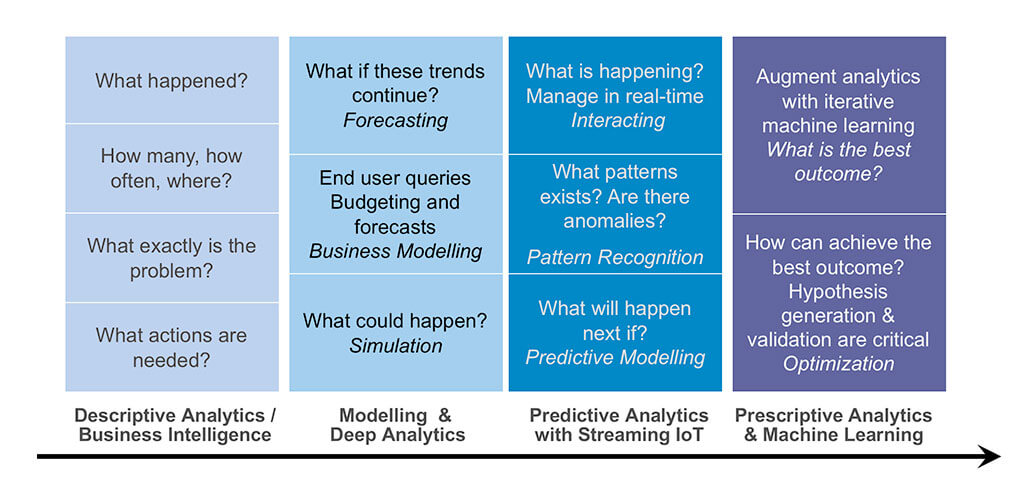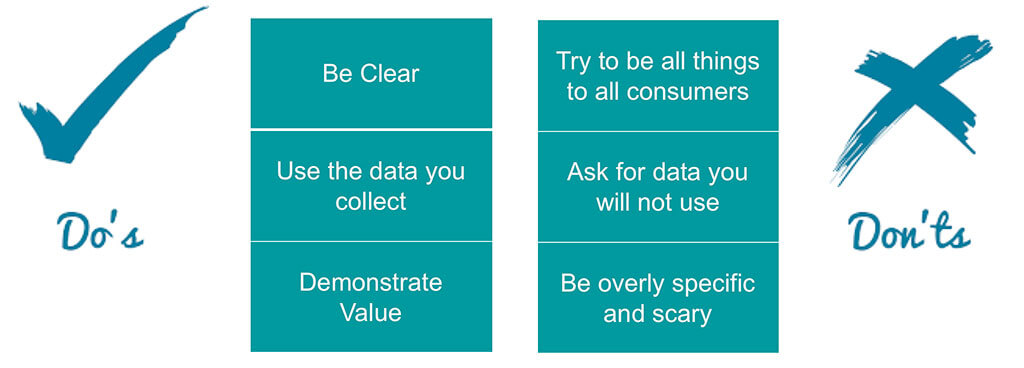While you might not consider ethics in AI a primary concern for your business, consider…
From Data to Decisions: The Silver Lining of GDPR
Revitalizing Customer Relationships via data capture in business to consumer sectors!
In this blog, we will consider the ‘what, why and how’ to keep consumer data in Business to Consumer organizations, in particular in the retail and travel industries. These findings apply across the board to those who communicate and store specific personal data.
GDPR: When you hear these four letters, does it bring angst to you and your Chief Data Officer (CDO) and Chief Security Officer (CSO)? Concerned that your company hasn’t really strategically thought about its data? Now, given enhanced regulations around personal data in the EU, each organization is required to address what and how it is thinking about its consumers’ information. No, I’m not going to lecture nor purport about the virtues nor the pains of ‘GDPR’ – General Data Protection Regulation for the EU (as well as global) citizen. Rather than panic about the legislation, it is an opportunity for all companies to consider and design exactly what to do with customer details in order to unlock the data’s real value. It is a great time to seize the opportunity to become a more data-centric, data-driven enterprise.
How best to do this – and know how to legally do this – are critical questions.
From analytics to strategic planning, from insight to hyper-personalized action, organizations keep and use personal information with the goal of providing ‘service’ to loyal buyers, to understand shopping, purchase, and decision criteria in order to predict and influence future behavior and ultimately drive more revenue.
For a professional life time, I have been working with organizational data as a subject. What started as simple anonymous purchase trending and profiling has transformed to contextual, real-time hyper-personalization. Companies are analyzing interactions and tailoring messaging to make consumer purchase-path streamlined and even second nature with a single click to execute the buy. Why, how and to what benefit are the questions for today’s blog (See in the post script the upcoming part 2 and part 3 blogs).
Why keep data at all?
The immediate questions right now that firms should be asking are: – why do we keep customer data and how do we explain its capture, usage and value to our customers. And of course, underpinning those questions is the hypothesis that there is benefit in keeping data!
The basic premise is simple:
companies analyze data to better understand their selling patterns in order to engage consumers to purchase.
The basic premise is simple: companies analyze data to better understand their selling patterns in order to engage consumers to purchase. Understanding what sells and what is in demand enables companies to better position their products and services in the market, beat competitors and succeed. [The data-driven organization is 5x more successful than those not based upon information – see link to our infographics: Data to Dollars Infographics
Yet in the era of individualism, with millennials driving multi-dimensional buying paths, customers don’t buy the same items and demand is varied. As a start, companies look to classic promotional understanding with the hope of driving short-term revenue; in the medium to long term, the desire is to drive repeat buying and ‘customer loyalty’.
Data kept for buying analysis starts with analyzing historical buying trends, the formative building blocks of understanding customer behavior. Equipped with this information, marketers initiate efforts to influence behavior and purchase decisions. With sophistication and the support of ever-increasing technology capabilities, business teams can explore data, build logic rules and create elaborate scenario testing. The output is detailed interactions with consumers over multi-step campaigns attempting hyper-personalized, relevant messaging to encourage continual purchase decisions.
In the coming years, we will see a shift from beyond digital transformation to something more of as ‘intelligent enterprise’ that has founded it’s true data into continual learning.
Knowledge can be gained as purchase behavior data is kept and analyzed. Combined with interactional data, sentiment analytics and today’s machine learning, data is the foundational, building the opportunity to move from simple to more complex topics.
- What has been sold to whom, why did some potential buyers abandon purchase
- What is in demand, what is not
- Can a ‘trigger’ be identified that led to a purchase event
- What item is next most likely to sell or be bought in combination
- Which channels are browsing and shopping channels, which channels are transactional
Over time, data is analyzed to create models that predict and even prescribe likely events. These become more complex and are addressed on this site [Data Science – Use Cases] as well as on countless other sites. Data-driven intelligence is being extended and more and more augmented with machine learning, orchestrated by Artificial Intelligence (AI) capabilities. Technology has advanced to enable repetitive analytic tasks to be routinized and run in real-time in the background. In the coming years, we will see a shift to beyond digital transformation to something more of an ‘intelligent enterprise’ that has founded its trusted data into continual learning.
Some broad categories of customer analytics are highlighted in the below diagram: Descriptive (historical trends); Deep Analytics and Modeling (pattern recognition and business forecasts); Predictive Analytics based on real time information (what is happening and can we position it now); and Prescriptive Analytics Augmented by Machine learning capabilities (this is what you should do, where endless models are tested and analyzed, with the support of a business expert, to determine more optimal outcomes.

Multi-channel, omni-channel or ‘channel less’ selling have arisen, as more and more paths to purchase are available… Digitization of experiences mean a wealth of data is available about both customers and product…
Multi-Channel, omni-channel or ‘channel-less’ selling have arisen, as more and more paths to purchase are available. What once was store-driven is now internet, mobile or even social channel driven. Further complicating matters, a shell of a product may be available but needs to be tailored (by size, colors, speeds, duration etc) before it can be actually transacted.
In the next part of this blog,(to answer the questions of which data to keep, how to keep it, and most importantly how to capitalize on it) I’ll consider some of the critical data elements to be captured including
- Profiles (i.e. identity, demographics, income, credit)
- Behaviors (i.e. shopping & browsing channels, buying patterns, research)
- Context (i.e. Geo-gating, notifications, desire to be promoted at specific timing)
- Sociability/User Generated Content (i.e. Product feedback, ratings, experience sharing)
- Preferences (i.e. willing to share with vendors)
What to tell the consumer
Indeed, a delicate question is what to tell the consumer that you are collecting data, as it is now a legal requirement. I have seen updates from retailers that are simply confounding. For the past few years as retailers have embraced data, there has been an elephant in the room as the store clerk asks for an email address, or worse, a mobile number! Often ill-equipped to handle this, associates usually fumble and offer that no one is obligated to provide information if they do not wish. With GDPR, a real elephant has arrived into the room. Probably like most of you and like most consumers, this month alone I have received a barrage of emails asking for my consent. Some of these emails are truly confounding. Probably the example that resonates the most poorly with me is : “Don’t let GDPR end our relationship”. For me, this is an exact invitation to do just that – end the relationship.
So what to do? Rather than shy away from this question – embrace it. Be excited that there is an opportunity to reveal and share your intention. To bring customers on the journey and gain their consent, let’s start with simple and easy to imagine scenarios. Car manufacturers today collect IoT (Internet of Things) data about devices. Modern smoke detectors collect temperature data. I can imagine allowing my smoke detector to collect temperatures in my home – in order to proactively detect a potentially dangerous, over-heated situation.
Now, let’s think about how this ought to apply to consumers with their data and how to demonstrate the value of using information. Let’s take a few examples. Amazon is trialing this belief in their recently founded Amazon Book Stores. They have made the decision to only stock books in store that are ‘best seller’ lists or highly rated by its prime customers. They have approximately 3000 books, compared to 10,000 or more in a typical suburban book store. Of course, in the store you can order any book they sell, but only the highly preferred books are available for purchase. The decision criteria is powered by customer data and customer preferences. It powers their business. We are all awaiting the results of this trial!
Let’s try another sector. Most of us will have stayed in hotels and may have been asked about pillow types and floor preferences. When asking these questions, the best answer would be to only deliver preferred pillow types to your room! In the world of retail, the offer might be sizing, style or color preferences only offering you items that you preferred and never items you do not wish. Take this one step further and you could image a virtual dressing room that offered you clothing that was of your color and design fashion only, while still recommending new items to discover!

As a specific thought to embrace in this blog, there are many moving parts in data creation, technology and machine learning. It is imperative to stay focused on tangible goals and wins. Do what you say and say what you do. People must govern and control data, algorithms and uses. Technology can find many notions in data, but they may even be scary or give the creep factor. While we many know pertinent facts about people (i.e. death in the family, loss of employment, pregnancy etc), we would never want to offer such specific information even if we have the perfect ‘solution’ to their newly emerging state. Trusted data, governed by subject matter experts, where business rules are tested and reviewed by people, is a good start to ensure intelligent usage.
Tell us your preferences (i.e text me offers on Tuesdays) and styles (i.e. organic, environmentally-friendly) so that we ensure it ‘fits’ you (i.e. offer only locally produced items)
So when it comes to knowing what to say to your customer, but more importantly demonstrate, that you will use their personal information to specifically tailor what, why and how your firm will create an buying experience designed to their specific preferences. Ensure them that you keep information on your communication preferences so that we only contact you the way you like it. “Tell us your preferences (i.e text me offers on Tuesdays) and styles (i.e. organic, environmentally-friendly) so that we ensure it ‘fits’ you (i.e. offer only locally produced items) the way you like (i.e. via Instagram and YouTube) and we only offer items that are of interest to you (i.e. check-out local farm products in next week’s market – see embedded video link and your personal discount code). Philosophically, I trust this is logical. Keep customer data that allows you to understand buying patterns. Specifically tell consumers you will keep data and use it to hyper-personalize messaging, execute on that decision and all will be well.
Uncomfortable with GDPR?
The silver lining is that as you (re)consider your approach to customer data, use this opportunity to move towards a data-driven enterprise!
Circle back to Data To Dollars to learn more about how data is driving these initiatives and keep up to data on digital transformation projects.
Thank you!
Rebecca Bucnis is the Managing Principal, Data To Dollars.
